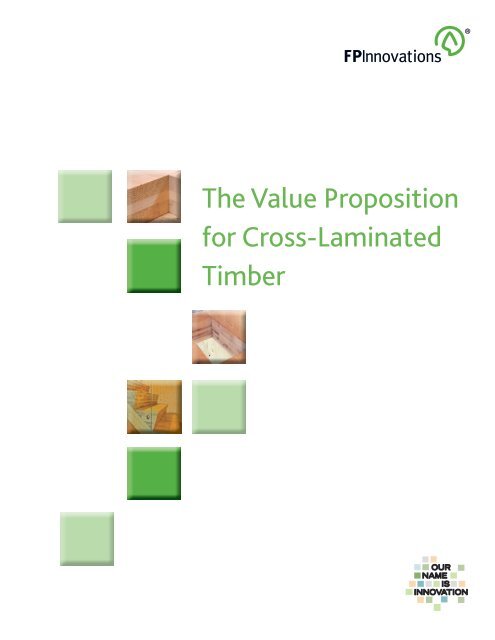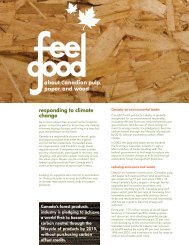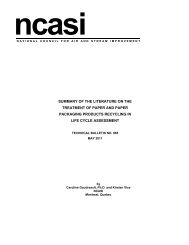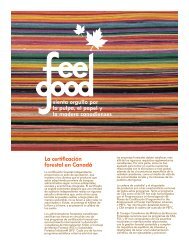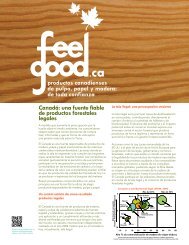The Value Proposition for Cross-Laminated Timber - Forest Products ...
The Value Proposition for Cross-Laminated Timber - Forest Products ...
The Value Proposition for Cross-Laminated Timber - Forest Products ...
Create successful ePaper yourself
Turn your PDF publications into a flip-book with our unique Google optimized e-Paper software.
<strong>The</strong> <strong>Value</strong> <strong>Proposition</strong><br />
<strong>for</strong> <strong>Cross</strong>-<strong>Laminated</strong><br />
<strong>Timber</strong><br />
OUR<br />
NAME<br />
IS<br />
INNOVATION
1<br />
Table of Contents<br />
1<br />
2<br />
3<br />
Introduction 1<br />
About the Methodology 3<br />
Need 5<br />
3.1 DETAILED NEEDS ANALYSIS 5<br />
4<br />
5<br />
6<br />
7<br />
8<br />
Approach 7<br />
4.1 DETAILED SHORT-TERM APPROACH: FLOOR SLABS 8<br />
4.2 DETAILED MID-TERM APPROACH 1: INDUSTRIAL BUILDINGS, THE TILT-UP<br />
CONCRETE SEGMENT 9<br />
4.3 DETAILED MID-TERM APPROACH 2: PRE-DESIGNED BUILDING PORTFOLIO:<br />
PARKING GARAGES 11<br />
4.4 DETAILED LONG-TERM APPROACH: CUSTOM PROJECTS 11<br />
4.5 DEFINING THE DISTRIBUTION CHANNELS 11<br />
Benefits 13<br />
5.1 MANUFACTURING COSTS 14<br />
5.2 CONSTRUCTION TIME 15<br />
Competition 17<br />
Conclusion 19<br />
Literature Cited 21<br />
Bio-pathways is a joint project<br />
among FPInnovations, FPAC, the<br />
CFS, and provincial governments<br />
in BC, Québec, Ontario. <strong>The</strong><br />
Focus of the project was “How<br />
to support the <strong>for</strong>est sector in<br />
choosing the right Trans<strong>for</strong>mation<br />
Strategies” It has been a two<br />
phase project with this document<br />
beginning release under the<br />
second phase which had a market<br />
focus.
1<br />
Introduction<br />
As part of Bio-pathways II the team was asked to look in detail at the market <strong>for</strong> some of the<br />
technologies on the list. This was phrased as a deep dive and it was decided that the first deep dive<br />
should be made on <strong>Cross</strong>-laminated <strong>Timber</strong> (CLT) as it was one of the more promising technology<br />
options. This document contains that deep dive presented in a NABC <strong>for</strong>mat (Market Needs,<br />
Approach to Market, Benefits of the <strong>Products</strong> and Competition).<br />
CLT is a cost-competitive wood-based solution that complements existing light- and heavy-frame<br />
building options. It is a suitable substitute <strong>for</strong> some building types which currently use concrete,<br />
masonry and steel. It is fast to erect, environmentally sound, per<strong>for</strong>ms well and represents an<br />
important outlet <strong>for</strong> the <strong>for</strong>est industry, without disrupting the existing value chain. Below is a<br />
summary of NABC findings <strong>for</strong> <strong>Cross</strong>-laminated <strong>Timber</strong>.<br />
Need (What is the Important Quantitative Customer and Market Need)<br />
Developers demand a fast building system, allowing <strong>for</strong> faster capital turnover that is<br />
cost-competitive against other systems.<br />
• Large demand in the mid-rise construction industry (70 to 200 million square feet of floor<br />
area/year)<br />
• <strong>Forest</strong> industry needs further penetration in non-residential markets (1 to 3 BBF/year<br />
opportunity)<br />
• New outlets are needed <strong>for</strong> small dimension lumber and low-quality lumber (e.g., MPB-cracked)<br />
• Occupants demand a livable space, that is energy-efficient and cost-competitive<br />
Approach (What is the Specific Quantitative Approach to satisfying that need).<br />
• Define short-, mid- and long-term goals <strong>for</strong> the CLT business, e.g.,<br />
• Short: Floor slabs, focus: res and non-res<br />
• Mid1: Floors and walls, focus: industrial<br />
• Mid2: Entire buildings from limited portfolio based on competitiveness<br />
• Long: Custom projects<br />
• Build partnerships and alliances to better access the market; sawmills, distributors, developers<br />
• Approach immediate projects via one-offs<br />
• Support advocacy groups to increase awareness<br />
• Support developing a generic product standard<br />
• Draw from its environmental credentials to seek subsidies/credits, government building<br />
programs<br />
• Build expandable plants as demand increases<br />
1
Benefits (What are the quantitative Benefits per Costs from the Approach)<br />
• 10 to 50% less expensive shell costs<br />
• Good environmental credentials (e.g., high carbon storage, and less greenhouse gas emissions)<br />
• Prefabricated system (fast, safe, precise)<br />
• Good seismic, fire and acoustic per<strong>for</strong>mance<br />
Competition (Who is the Competition and what are the alternatives now and in the future, and why are<br />
your Benefits per cost superior)<br />
CLT competes – in cost and socially – favorably with concrete/steel buildings, especially in the non-residential<br />
and multi-family mid-rise market niche. Another competitive type is industrial buildings, typically<br />
built with tilt-up concrete, which are simple, profitable and represent a large demand. Low-rise educational<br />
is also attractive.<br />
2
2<br />
About the Methodology<br />
<strong>The</strong> NABC value assessment method was developed by SRI (Stan<strong>for</strong>d Research Institute) and it has been<br />
adopted by FPInnovations. NABC stands <strong>for</strong> Needs, Approach, Benefits and Competition. <strong>The</strong>se four<br />
categories try to answer the following questions:<br />
Needs – What is the important customer and market Need<br />
Vision / Mission statement<br />
Key Capabilities<br />
Strategy<br />
Who is the customer<br />
What does the customer need<br />
Approach – What is the unique Approach <strong>for</strong> addressing this need<br />
Product or Service descriptions<br />
Benefits – What the specific Benefits per cost that result from this approach<br />
How will the customer benefit from this<br />
What is the $ value of the benefit and how much will it cost to implement<br />
How much of the market will this allow you to capture<br />
Competition – How are these benefits per cost superior to the Competition’s and the alternatives<br />
What is the competition/Who is the competition<br />
<strong>The</strong> NABC puts a significant amount of emphasize on quantifying the results/metrics used in the analysis.<br />
It also focuses heavily on understanding the ‘ecosystem’ surrounding the market and product. A NABC<br />
can be used to assess the impacts of an initiative on various stakeholders however in this report NABC presented<br />
is designed from the perspective of someone in the <strong>for</strong>est industry wanting to enter the CLT market.<br />
3
3<br />
Need<br />
<strong>The</strong> fundamental need in the marketplace is the demand of developers <strong>for</strong> fast building systems that are<br />
cost-competitive with other systems allowing them to increase their capital turn over and reduce project<br />
risk. In order to further understand this Need, FPInnovations examined in detail the use of building systems<br />
in various commercial and residential applications, and estimated the potential size of the Need. <strong>The</strong><br />
findings are below:<br />
• <strong>The</strong>re is a need <strong>for</strong> viable prefabricated systems suitable <strong>for</strong> use in both residential and non-residential<br />
applications. CLT can serve both.<br />
• Multi-family construction is on the rise. CLT is well suited, especially <strong>for</strong> 5+ storeys. Light wood-frame<br />
dominates the 1 to 4 storey segment.<br />
• Current non-res buildings in wood are limited to low heights, mostly 4-storeys or less. CLT can help<br />
increase wood’s share.<br />
• Market share <strong>for</strong> wood in non-residential construction is low, with less than 10% of the 1.3 billion sq. ft.<br />
($228 billion) US market (2008) and 6% of the 5- to 6-storey residential. CLT is especially suited to help<br />
stop the erosion of wood to steel/concrete.<br />
• <strong>The</strong> Canadian <strong>for</strong>est products industry needs to diversify its product portfolio, especially seeking valueadded<br />
alternatives. CLT does not require high-end lumber and it can be an outlet <strong>for</strong> less valuable species<br />
or grades.<br />
• Depending on the penetration rate used CLT could represent a 0.84 to 2.4 billion bf market (see Figure 1).<br />
Floor area<br />
(Millions ft 2 )<br />
CLT<br />
(Million m 3 )<br />
Lumber<br />
(BBF)<br />
Shell <strong>Value</strong><br />
($ Billion)<br />
5% 15%<br />
Storey class 5% 15% 5% 15% 5% 15%<br />
Low-rise (1 to 4)<br />
52<br />
156<br />
0.9<br />
2.7<br />
0.6<br />
1.8<br />
1.1<br />
3.3<br />
Mid-rise (5 to 10)<br />
16<br />
48<br />
0.3<br />
0.9<br />
0.2<br />
0.6<br />
0.4<br />
1.2<br />
Total<br />
68<br />
204<br />
1.2<br />
3.6<br />
0.8<br />
2.4<br />
1.5<br />
4.5<br />
Note: <strong>The</strong> Canadian market can be estimated at 5 to 10% of the US market on a floor area basis.<br />
Figure 1. Market Opportunity <strong>for</strong> CLT by Scenario. From: <strong>Cross</strong>-laminated <strong>Timber</strong>: a Primer FPInnovations. 2010.<br />
Two scenarios were considered <strong>for</strong> market penetration rates 5%/15%. <strong>The</strong> 15% penetration rate was used<br />
as a mid to longer term estimate.<br />
3.1 Detailed Needs Analysis<br />
Wood currently has a 10% share of the US non-residential market (Figure 2 shows the US non-residential<br />
market by State, storey class, and wall frame (000 sq. ft.). This market segment has shown some resiliency<br />
to the economic crisis, however 2009 was marked by a strong decrease in construction area (-40%). This<br />
report assumes the markets will pick up, and uses 2008 volumes as a proxy <strong>for</strong> near term demand. Since the<br />
Canadian market is only 5 to 10% of the US market, the focus is on the US.<br />
1<br />
See report ‘A Strategic Plan <strong>for</strong> the Commercialization of CLT in North America’. 2010. Natural Resources Canada<br />
5
In the analysis of the non-residential market we split the market into two separate classification; 1-to<br />
4-storeys and 5+ storeys. This approach was taken to ensure that in the analysis we were taking into<br />
account the effect of current wood use in 1- to 4-storey buildings. Also on the maps presented, the size of<br />
the market is represented by the size of the pie chart. As a result we were able to identity both the specific<br />
application in which CLT could be competitive, and the size of that market.<br />
<strong>The</strong> overall market estimated is based on an average usage factor of 0.62 ft 2 of CLT per ft 2 of construction<br />
area and 17.5 board feet of lumber per ft 3 of CLT. <strong>The</strong>se volumes were tallied up by building type and storey<br />
class, assigning a competitiveness factor to CLT <strong>for</strong> each case and multiplying this factor by the market<br />
size 1 . As stated, the stats correspond to 2008 (McGraw-Hill), grossed up by 25% to adjust <strong>for</strong> sampling<br />
issues. To estimate the volume of wood or size of the market the study looked only at the shell of the<br />
building. <strong>The</strong> shell corresponds to the structure of the building – basically floors and exterior walls. <strong>The</strong><br />
shell value is the product of the estimated total footage by assembly and the unit cost <strong>for</strong> CLT ($8 to $11<br />
per ft 2, depending on panel thickness).<br />
Although not completed in the same detail as building type, FPInnovations also explored different options<br />
to utilise CLT including:<br />
• Elevator shafts and stairwells: 0.2 to 0.4 BBF<br />
• Balconies and stairs: N/A<br />
• Additions to existing buildings<br />
• Parkades.<br />
Sales to these applications were not included in the Need <strong>for</strong>ecast.<br />
Figure 2.<br />
Non-residential Market by State, Storey Class<br />
and Wall Frame (000 SqFt.). <strong>The</strong> size of the circle<br />
represents the relative size of the market. For<br />
example, New York uses about 20% of wood in their<br />
1- to 4-storey buildings but they do not use wood in<br />
5 to 10 storeys.<br />
Wall Frame<br />
Light Gauge Steel<br />
Pre-Engineered Metal<br />
Pre-Fabricated Modular Comp<br />
PrecastConcrete<br />
Rein<strong>for</strong>ced Concrete<br />
Structural Steel<br />
Wall Bearing<br />
Wood<br />
6<br />
1<br />
See report ‘A Strategic Plan <strong>for</strong> the Commercialization of CLT in North America’. 2010. Natural Resources Canada
4<br />
Approach<br />
In developing the Approach <strong>for</strong> potential CLT manufacturers, FPInnovations looked at several strategies<br />
and identified one strategy <strong>for</strong> the short-, medium- and long-term approaches. We also reviewed possible<br />
distribution channels <strong>for</strong> the product. <strong>The</strong> summarized findings <strong>for</strong> the Approach follow:<br />
• CLT Manufacturers:<br />
• Define short-, mid- and long-term goals, e.g.,<br />
- Short: Floor slabs, focus: res and non-res<br />
- Near Mid: Floors and walls, focus: industrial<br />
- Far Mid: Entire buildings from limited portfolio, based on competitiveness<br />
- Long: Custom projects (Europe Model)<br />
• Industry at large (rest of the stakeholders):<br />
- Build partnerships and alliances to better access the market; sawmills, distributors, developers<br />
- Approach immediate projects via one-offs<br />
- For the short-term a proprietary approach is OK, e.g., APA stamp<br />
- Make sure the demonstration buildings (NRCan) are built and properly showcased<br />
- Align North American industry around the development of a generic product<br />
- NLGA/CSA 086<br />
- Import and test European panels to support code approval <strong>for</strong> the US and Canada<br />
- Encourage partnerships with leading companies, e.g., KLH North America<br />
- Develop training venues, e.g., carpentry, CNC/CAD operation, building inspectors<br />
- Increase awareness at Universities so future specifiers know about it<br />
- Showcase panels at trade shows<br />
• Display integrated solutions:<br />
- Insulation, HVAC, connectors/fasteners, pre-fitted electric system<br />
- Explain economics (building savings <strong>for</strong> shell and total, plus savings in time, work out example <strong>for</strong><br />
large multi-unit projects )<br />
- Seek awareness/approval among specifiers (architects, engineers) and developers<br />
- Environmental virtues, construction time, flexibility of design (CNC machines), per<strong>for</strong>mance and<br />
code compliance<br />
- Target tilt-up concrete buildings, industrial, mid-rise res/non-res (5+), floor slabs<br />
- Manufacturers could produce custom-made panels and/or raw panels to be further processed by<br />
the builder or by the pro dealer/wholesaler (e.g., cut floor slab to size and spline it <strong>for</strong> joint)<br />
- Simulations have shown a roughly balanced demand <strong>for</strong> floor and wall panels.Similarly,manufacturing<br />
costs seem to be equivalent, regardless of the assembly type<br />
In order to provide the wider picture each approach needed to be detailed so the impacts of the approach<br />
could be better understood.<br />
7
4.1 Detailed Short-term Approach: Floor Slabs<br />
In the detailed short-term strategy it was assumed the company would want to manage its investment<br />
and risk and run a very lean facility without needing complicated computer controlled equipment or<br />
higher overhead from an extensive sales team. <strong>The</strong>re<strong>for</strong>e it was assumed that the company would move<br />
directly into full building assemblies.<br />
• It may make economic sense to enter the market with floor slabs:<br />
- Large demand (600 million sq.ft.)<br />
- Less code burden<br />
- Building inspectors like it because of lower chance of collapse during fire<br />
- Easier to fabricate and build with<br />
- More profitable <strong>for</strong> CLT manufacturer (simpler, less waste)<br />
- Easier to ship.<br />
• Floor systems may eventually find a way into the single-family residential market. Preliminary<br />
benchmark analysis suggests this may be feasible in the high-end segment.<br />
• In the future, a manufacturer can grow to include both assembly types.<br />
• Furthermore, a CLT manufacturer could include the manufacturing of columns and beams (as a<br />
by-product or as a second line) similar to glulam to take advantage of the available panels and or<br />
capabilities and reduce costs v. glulam. At the very least, partner up with a glulam or Parallam TM<br />
manufacturer.<br />
• Other applications and/or byproducts may include stair steps. <strong>The</strong> common practice in Europe is to<br />
grind the residues and burn them <strong>for</strong> energy.<br />
• Eastern Canada likely to use small dimensions, like 2x3s and 1x4 (spruce and pine).<br />
• Western Canada likely to use 2x6s and 2x4s (SPF).<br />
• Research should look at using lesser known species, e.g., poplar and higher moisture content, e.g., 19%.<br />
• Research on using low-quality (cracked) MPB-killed lumber is needed.<br />
1200K<br />
100K<br />
800K<br />
600K<br />
400K<br />
200K<br />
Elev.<br />
Ext.<br />
Partitions<br />
Roof<br />
0K<br />
Floors<br />
Walls<br />
Figure 3. Demand by Assembly<br />
Figure 4. Stair steps using 9-ply CLT<br />
8
4.2 Detailed Mid-term Approach 1: Industrial Buildings, the Tilt-up Concrete<br />
Segment<br />
One potential next step <strong>for</strong> a CLT manufacturer is to target whole building development. In this approach<br />
it is assumed that the manufacturer moves first to more standardized buildings such as tilt-up concrete<br />
structures.<br />
• Industrial buildings are especially suitable <strong>for</strong> CLT assemblies. This market segment is large and<br />
dominated by concrete and steel (see Figure 5).<br />
• This segment is especially suitable <strong>for</strong> CLT penetration. <strong>The</strong>se buildings are found in business/industrial<br />
centers and have the following features:- Low rise (1-to 2-storeys)<br />
- Tall storey heights (10’-to 24’)<br />
- Box-type shape<br />
- Flat roof<br />
- Large window area in the front, the rest without openings<br />
- Long spans.<br />
• Warehouses are typically built with tilt-up concrete and/or steel.<br />
• Self-storage warehouses are normally built with concrete blocks.<br />
• <strong>The</strong>se two types represent a significant share of the non-res market see Figure 6.<br />
• Studies have shown that a 5-ply CLT tall wall plus metal siding is cost-competitive <strong>for</strong> box-type<br />
warehouses.<br />
• Self-storage warehouses are typically built using concrete blocks and are very economical and hence<br />
difficult to compete with on a cost basis.<br />
• Building safety is important in these markets.<br />
Offices<br />
Dorms<br />
Health<br />
Public<br />
Recreational<br />
Floor Areas by Material: 1-4 Industrial<br />
Stores<br />
Schools<br />
Religious<br />
Industrial,<br />
243,237<br />
Micellaneous 23%<br />
Parking<br />
Wall Material<br />
wood<br />
concrete<br />
metal<br />
Wood Share<br />
0.00-0.01<br />
0.01-0.05<br />
0.05-0.19<br />
0.19-0.46<br />
United States of America MGH 227<br />
Figure 5. Industrial Floor Areas by Material: 1-to 4-Storey<br />
9
Figure 6. Typical Tilt-up and Self-storage Buildings<br />
Figure 7 takes a closer look at the industrial segment, with a focus on the 1- to 2-storey precast concrete<br />
segment. This segment accounts <strong>for</strong> 69 million ft 2 of annual construction area, with warehouses having the<br />
largest share (57%). This segment would represent a demand of 1.7 to 5 million ft 3 of CLT <strong>for</strong> the 5 to 15%<br />
scenarios .<br />
70K<br />
1-2 Stories Precast Concrete 2008 Grand<br />
Total<br />
69,020<br />
65K<br />
60K<br />
55K<br />
Construction Area (000 SqF)<br />
50K<br />
45K<br />
40K<br />
35K<br />
30K<br />
25K<br />
20K<br />
39,150<br />
15K<br />
10K<br />
6,336<br />
6,307 6,084<br />
5K<br />
2,515 2,809<br />
907<br />
3,289<br />
1,622<br />
0K<br />
Amusement,<br />
Social and..<br />
Government<br />
Service Bu..<br />
Hospitals<br />
and Other..<br />
Manufacturing<br />
Plants, W..<br />
Office and<br />
Bank Bui..<br />
Parking<br />
Garages an..<br />
Schools<br />
Libraries, a..<br />
Stores and<br />
Restaurants..<br />
Warehouses<br />
(excl. manuf..<br />
Total<br />
10<br />
Figure 7. Construction Area by Building Type (1- to 2-Storey Precast Concrete)<br />
At 0.48 ft 3 /ft 2
4.3 Detailed Mid-term Approach 2: Pre-Designed Building Portfolio: Parking<br />
Garages<br />
Another mid-term approach is to look at pre-designed buildings. Each installation of these types<br />
of buildings are similar in nature, so although they do have components that are custom to a<br />
specific building the bulk of the building system is reproducible. An example of this is parking<br />
garages where the main structure is very similar while the outside look may be customized.<br />
• Preliminary studies have shown CLT to be cost-competitive (similar) with concrete.<br />
• Building code allows up to 5-storeys in heavy timber, once certain conditions are met.<br />
• Wood has environmental advantage.<br />
Figure 8. Skelleftea Parking Garage (Sweden)<br />
4.4 Detailed Long-term Approach: Custom Projects<br />
This is the European model, where the CLT manufacturer works on a by-project basis. This strategy calls<br />
<strong>for</strong> a somewhat more mature market, with greater acceptance of the product. Under this model, the CLT<br />
manufacturer must have a well developed sales and engineering <strong>for</strong>ce along with effective networks in the<br />
construction and design communities.<br />
4.5 Defining the Distribution Channels<br />
A look at the demand by metro area helps identify potential locations <strong>for</strong> manufacturing plants as well as<br />
distribution channels and shipping costs (Figure 9). It can be seen that the demand is concentrated in the<br />
East, with two other important areas, one around the Great Lakes and the other in the Southwest. Overlaying<br />
transportation costs and networks on this detailed analysis of the market will help CLT users understand<br />
the right approach by market. For example, serving a custom building market in the US South will have<br />
additional challenges posed by transportation and the need <strong>for</strong> very tightly scheduled deliveries. A CLT<br />
entrant may choose to focus on custom buildings close to their manufacturing but provide blanks or floor<br />
slabs to markets farther away.<br />
11
Figure 9. CLT Demand by Metro Area (5% Penetration)<br />
Note: Gold color text indicates less importance<br />
12
5<br />
Benefits<br />
<strong>The</strong> market assessment completed was based on comparing the installed cost of concrete or another<br />
building system vis-à-vis the estimated installation cost of CLT. Based on this analysis the market size and<br />
locations were determined. This analysis does not represent all the benefits of CLT. <strong>The</strong>re are significant<br />
other savings in using the material that will mainly accrue to the builder or developer rather than the CLT<br />
producers (depending on market management and bonus plans). Figure 10 summarizes the benefits of CLT<br />
by stakeholder, from lumber producers to occupants of CLT buildings.<br />
LUMBER<br />
PRODUCER<br />
CLT<br />
PRODUCER<br />
DESIGNER BUILDER OCCUPANTS<br />
Environmental per<strong>for</strong>mance<br />
Large market opportunity<br />
Environmental per<strong>for</strong>mance<br />
Design flexibility<br />
Structural per<strong>for</strong>mance<br />
Construction speed<br />
Cost competitiveness<br />
Large market opportunity<br />
Environmental per<strong>for</strong>mance<br />
Design flexibility<br />
Structural per<strong>for</strong>mance<br />
Construction speed<br />
Cost competitiveness<br />
Large market opportunity<br />
Livability<br />
Environmental per<strong>for</strong>mance<br />
Design flexibility<br />
Structural per<strong>for</strong>mance<br />
Construction speed<br />
Cost competitiveness<br />
Large market opportunity<br />
Livability<br />
Environmental per<strong>for</strong>mance<br />
Design flexibility<br />
Structural per<strong>for</strong>mance<br />
Construction speed<br />
Cost competitiveness<br />
Livability<br />
Figure 10. Benefits by Stakeholder (From CLT Primer)<br />
Other benefits include:<br />
• Significant savings in construction time vs. poured concrete (several weeks).<br />
• Building System Per<strong>for</strong>mance:<br />
- It allows flexible design, has good acoustic, fire and insulation properties<br />
- Can be combined (e.g., glulam, Parallam, steel)<br />
- It per<strong>for</strong>ms well under earthquake conditions, even <strong>for</strong> multi-storey buildings<br />
- Good fire per<strong>for</strong>mance and acoustics<br />
- Vibration and creep critical but can be solved.<br />
• Environmental Per<strong>for</strong>mance:<br />
- Favourable preliminary life cycle analysis against steel, with 1:20 greenhouse emissions<br />
- High levels of CO 2 sequestration (0.75 tons/m 3 ).<br />
• Construction advantages (against poured concrete)<br />
- Rapid erection on site (other trades can begin work sooner, improved precision, e.g., cladding,<br />
windows, etc.)<br />
- Reduced noise from building sites<br />
- Provides an instant work plat<strong>for</strong>m with improved safety and little waste<br />
- Smaller/cheaper equipment (cranes, trucks)<br />
- Reduces job site impact and leaves a small footprint (little waste, panels could be disassembled).<br />
• Can be produced in Canada at a competitive cost, making it attractive <strong>for</strong> builders<br />
- $20/ft 3 in Canada (similar costs <strong>for</strong> west and east).<br />
• Attractive outlet <strong>for</strong> low quality lumber (cracked MPB lumber).<br />
13
5.1 Manufacturing Costs<br />
Figure 11 shows a summary of a simulation<br />
of manufacturing costs of CLT <strong>for</strong> a<br />
hypothetical plant based in Eastern Canada.<br />
This plant requires a total investment of<br />
$41 million, produces 30,000 m 3 of either<br />
floor assemblies or wall assemblies in<br />
panel thicknesses of 144 mm and 88 mm,<br />
respectively. A similar exercise <strong>for</strong> a Western<br />
Canada-based plant yielded similar results,<br />
with $17/ft 3 (variable costs) and $19/ft 3 total<br />
cost. <strong>The</strong> latter assumed 2x6 lumber whereas<br />
the Eastern-based simulation assumed 2x3s<br />
and 1x4s. Both cases consider S4S redried<br />
lumber, roughly at $400 per MBF.<br />
Equip. maintenance<br />
Labor (2 shifts) 15%<br />
Energy Fuel 2%<br />
Adhesive 8%<br />
$19/ft 2<br />
Packaging 1%<br />
Shipping 2%<br />
Financial expenses 11%<br />
Other 5%<br />
Wood 53%<br />
Output: 30,000 m 3<br />
106 million cubic feet<br />
Figure 11. Total Manufacturing Costs of CLT (Eastern Canada)<br />
Using the simulated costs (plus connectors, erection and markup) a cost-competitiveness analysis was<br />
per<strong>for</strong>med. For each building type and storey class, a realistic assembly <strong>for</strong> the CLT was chosen (panel<br />
thickness, insulation, façade, etc.). Unit costs <strong>for</strong> anything other than the panel itself came from RSMeans.<br />
<strong>The</strong> calculated square foot cost <strong>for</strong> the shell (walls + floors) was compared against the corresponding value<br />
from McGraw-Hill. Figure 12 shows an extract with the side-by-side comparison <strong>for</strong> 12 building types/<br />
storey classes.<br />
Apartment-L<br />
Residential<br />
Apartment-M<br />
Warehouse-L<br />
Industrial<br />
SS Warehouse-L<br />
Dormitory-L<br />
Dorms<br />
Dormitory-M<br />
Office-L<br />
Offices<br />
Office-M<br />
High School-L<br />
Educational<br />
School-L<br />
Motel-L<br />
Hotels<br />
Hotel-L<br />
Shell Cost ($/ft 2 )<br />
Shell Cost ($/ft 2 )<br />
Shell Cost ($/ft 2 )<br />
Shell Cost ($/ft 2 )<br />
Shell Cost ($/ft 2 )<br />
Shell Cost ($/ft 2 )<br />
14<br />
Figure 12. Cost-competitiveness Analysis
In addition to analysing a whole building approach we also analysed a component approach. Detailed<br />
Short-term Approach: Floor Slabs (Section 4.1) would be considered a component approach. In this<br />
analysis we specifically looked at the cost comparison of CLT against other systems <strong>for</strong> too components –<br />
floors and walls. Figure 13 shows the results of this analysis.<br />
For floors, depending on the specific design, CLT is competitive with CIP Beam & Slab. As a wall component,<br />
CLT competes well with many of the concrete options, such as Pre-cast Concrete.<br />
Floors<br />
Walls<br />
Assembly Costs ($/ft 2 )<br />
Assembly Costs ($/ft 2 )<br />
Figure 13. Benchmarking Analysis of Assembly Costs<br />
5.2 Construction Time<br />
CLT is an extremely fast building system. It requires small crews and simple equipment. Time savings should<br />
result in important savings in capital and faster project turn-up <strong>for</strong> developers. Below are some actual<br />
examples from Europe.<br />
15
Building Type: Educational, 3 Storeys<br />
Material<br />
Location<br />
Floor Area (ft 2 )<br />
Stories<br />
Construction Period<br />
Building Type: Residential, Mid-Rise<br />
Material<br />
Location<br />
Floor Area (ft 2 )<br />
Stories<br />
Construction Period<br />
16
6<br />
Competition<br />
For the ecosystem of CLT, FPInnovations looked at a series of issues including the viewpoint of designers<br />
and architects, other producers of CLT working in the same market, and equipment suppliers. At this point<br />
none of the hurdles registered as a ‘show stopper’ but the work did indicate that the producer needs to<br />
understand the market and stay close to the customer.<br />
• Designers prefer or are <strong>for</strong>ced by code to specify other incumbent materials such as concrete and steel<br />
<strong>for</strong> non-res buildings.<br />
• Other massive panels, such as Panaloc’s.<br />
• European manufacturers who could either ship panels or open plants in North America.<br />
• Other solutions, e.g., face-glued lumber <strong>for</strong> floors.<br />
• Other uses <strong>for</strong> the fibre or lack of suitable grades/dimensions/specie.<br />
• <strong>The</strong> US will likely open its own CLT plants if the product enters the market. <strong>The</strong>re is evidence of increasing<br />
awareness and interest in CLT in the US. Optimal plant location and partnership with local sawmills may<br />
provide Canada an edge.<br />
• KLH may hold proprietary technology on the pressing process (unlikely).<br />
17
7<br />
Conclusions<br />
• CLT has been successfully used in Europe. It works!<br />
• CLT-prefab systems hold great potential to increase their share as a construction system. Canada may<br />
have a competitive advantage in terms of supply and wood quality. Expertise and networking is also<br />
growing quickly.<br />
• CLT manufacturing is straight<strong>for</strong>ward and cost-effective against incumbents.<br />
• Preliminary cost analysis shows a CLT plant in Canada to be feasible.<br />
• Upfront construction costs are competitive when compared to concrete/steel <strong>for</strong> several building types<br />
and storey classes.<br />
• <strong>The</strong> North American market <strong>for</strong> CLT is estimated at 1.2 to 3.6 million m 3 , or 1 to 3 BBF, at 5 to 15% market<br />
penetration, respectively.<br />
• Main Applications: Tilt-up concrete buildings, industrial, mid-rise res/nonres (5+), floor slabs, other,<br />
• Main obstacles include: production capacity, code issues, resistance from construction community<br />
against wood-based materials, perceptions of: durability, fire, acoustics.<br />
19
8<br />
Literature Cited<br />
FPInnovations. 2010. <strong>Cross</strong> <strong>Laminated</strong> <strong>Timber</strong>: a Primer.<br />
http://www.<strong>for</strong>intek.ca/public/Eng/E3-R&D_Program/7.market.html<br />
Natural Resources Canada.<br />
2010. A Strategic Plan <strong>for</strong> the<br />
Commercialization of <strong>Cross</strong>-<br />
<strong>Laminated</strong> <strong>Timber</strong> in Canada<br />
and the US.<br />
21
ABOUT THE AUTHOR<br />
PABLO CRESPELL<br />
Pablo Crespell is a senior researcher in the<br />
markets and economics group with a focus on<br />
nonresidential construction. Pablo leads<br />
research on next generation building systems<br />
looking at new developments, tracking statistics<br />
and trends, and developing capabilities of<br />
construction costs’ appraisal and competitiveness<br />
analysis <strong>for</strong> wood systems.<br />
Ph.D Wood Science (Oregon State University),<br />
M.Sc. <strong>Forest</strong>ry (North Carolina State University),<br />
B.Sc. <strong>Forest</strong>ry (Universidad Austral de Chile).<br />
Email: pablo.crespell@fpinnovations.ca<br />
CHRIS GASTON<br />
Chris Gaston is National Group Leader, Markets<br />
& Economics based at FPInnovations in Vancouver,<br />
British Columbia. Chris has worked in both<br />
industry (management, consulting, research)<br />
and academics (teaching and research), with over<br />
25 years experience in agribusiness and <strong>for</strong>estry.<br />
His focus is on price risk management strategies,<br />
market research, econometrics and trade<br />
modeling. Recent research ef<strong>for</strong>ts have included<br />
supply chain management and product development<br />
<strong>for</strong> Canada, the United States, Japan, China<br />
and Europe.<br />
Ph.D. <strong>Forest</strong>ry Economics (University of British Columbia),<br />
M.Sc. Agricultural Economics & Business (University of<br />
Guelph),<br />
B.Sc. Agricultural Sciences (University of British Columbia).<br />
Email: chris.gaston@fpinnovations.ca<br />
®FPInnovations, its marks and logo are registered trademarks of FPInnovations.<br />
©2011 FPinnovations. All rights reserved.<br />
www.FPInnovations.ca
®FPInnovations, its marks and logo are registered trademarks of FPInnovations.<br />
©2011 FPinnovations. All rights reserved.<br />
www.FPInnovations.ca


